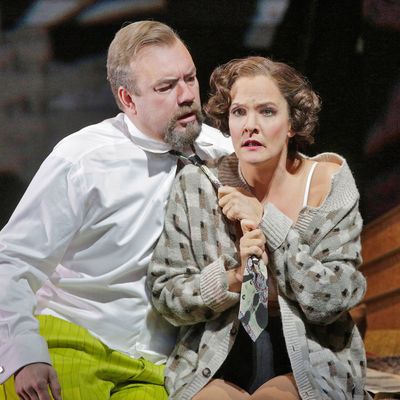
If the Metropolitan Opera decided to concentrate its entire mission into a single night, that show might look a lot William Kentridge’s production of Lulu. Berg’s 80-year-old opera is both a classic melodrama in need of tender care and a scary war cry of the avant-garde. Ghoulish drama and rich music come laced together, repackaged by a major visual artist with a natural feel for theater. Marlis Petersen wears the title role like a zip-on skin, and conductor Lothar Koenigs steers a swarm of singers and musicians to a common goal. Why can’t the Met get things this right all the time?
Lulu’s been a rarity in New York, and it returns thanks to James Levine, the only man who could strong-arm the company into a lavish production of such a dense and disturbing work. In the end, though, Levine didn’t feel healthy enough to conduct it, so the Met turned to Koenigs, a pretty deluxe sub. Blessed with one of the world’s great pit bands and a blemishless cast, he leads a performance of beautifully modulated incandescence.
But picking out one of two elements does a disservice to the production’s collective power. The essence of an immersive experience is that there’s more to see than your eyes can frame, more to hear than you can make out at any one time. Berg’s score is like that, so thick with events that the ear keeps swiveling from one to the other like a hyperactive satellite dish. Kentridge’s production is even more like that, a black-and-white cornucopia of projected ink drawings, dictionary pages, newspaper headlines, Expressionist paintings, Rorschach blots, woodcuts, great-man portraits and caricatures. Kentridge toggles back and forth between two and three dimensions, between brushstroke and flesh. Over the course of her long association with this role, Petersen has worn an impressive array of gowns, shifts, décolletages, and brothel-friendly underwear. Here, the costume designer Greta Goiris has taped a two-step drawing (curved line, dot) of a breast to her white blouse. Even her nakedness is a kind of flimsy dress-up.
I suppose a repeat viewer might eventually be able to assimilate this cataract of sounds and images, but that would defeat the purpose, which is to overwhelm. For at least a century, being overwhelmed has been one of the core experiences of modern life. Some artists — Ludwig Mies van der Rohe, Sol Lewitt — responded to chaos by paring their work down to essential geometries. Others (Frank Gehry, Jackson Pollock) produced writhing portraits of overload. In 1924, Berg wrote an admiring essay about his teacher Arnold Schönberg’s First String Quartet, titled “Why Is Schönberg’s Music So Hard to Understand?” The answer, Berg claimed, lay in the simultaneous riches being heaped upon the listener. Rhythmic relationships, melodic finesse, and harmonic ingenuities come so fast that listeners accustomed to simpler music will inevitably balk. The implication is that sooner or later the public would rise to the level of the invention, which in Schönberg’s case has never really happened. But in Lulu, there’s no mistaking the loathing, violence, and erotic obsessions that drive the characters. Despite its musical complexity and taut charm, it’s an opera of savage clarity.
The challenge of finding the balance between the brutal and the cerebral is what makes Petersen such a glorious Lulu (or rather made, since she has promised to retire the role after this run). She is neither a sulphurous temptress nor a cold technician, but a supple artist with a killer sashay, a gymnastic voice, and the character’s warped psychology embedded in her marrow. Lulu displays an inhuman nonchalance, and Petersen’s delivery of the question, “Isn’t this the sofa where your father bled to death?” — surely the best line about a piece of furniture in all of opera — is a masterpiece of chilly terror. Death is an operatic cliché, but nihilism’s not, and there’s an almost intolerable disjunction between the emotional urgency of Berg’s score and the dead souls who inhabit it.
Lulu, imprisoned by her own seductiveness, can only be a murderous blank, a dangerously passive screen on which the men in her life project their own fantasies and horrors. When the curtain rises, she is sitting for her portrait — literally waiting for a man to summon her into being. Four hours later, the final curtain drops on the body of a woman pushed by fear and instinct into a life of abject squalor. She spends the time in between encircled by predators: the painter (the ever-excellent Paul Groves), Countess Geschwitz (an aristocratically single-minded Susan Graham), Dr. Schön (John Reuter, sonorous and resplendent in a chartreuse suit), and the doctor’s son Alwa (the gorgeously fragile Daniel Brenna). As this constellation whirls, her personality keeps flying off in shreds, slicing through conventions, relationships, and men. In Kentridge’s telling, the only constant is the silent spirit of Lulu herself — a dancer who writhes ceaselessly on, and in, a glossy piano, incarnating the opera’s atmosphere of humid desire.
Lulu runs through December 3 at the Metropolitan Opera. The November 21 matinee will be broadcast to theaters as part of the Met’s Live in HD series.





